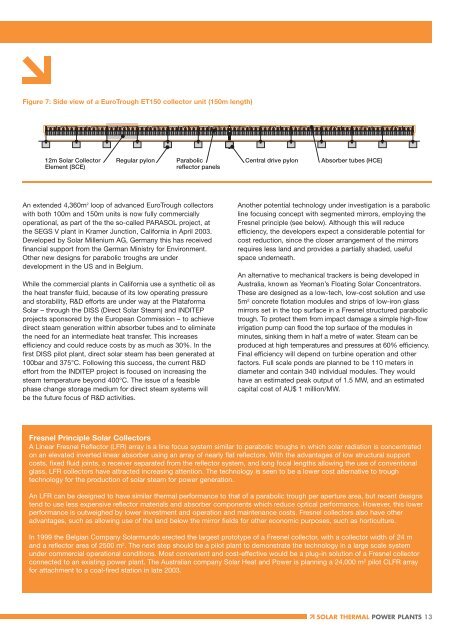solar thermal power - Greenpeace
solar thermal power - Greenpeace
solar thermal power - Greenpeace
Create successful ePaper yourself
Turn your PDF publications into a flip-book with our unique Google optimized e-Paper software.
Figure 7: Side view of a EuroTrough ET150 collector unit (150m length)<br />
12m Solar Collector<br />
Element (SCE)<br />
Regular pylon<br />
Parabolic<br />
reflector panels<br />
Central drive pylon<br />
Absorber tubes (HCE)<br />
An extended 4,360m 2 loop of advanced EuroTrough collectors<br />
with both 100m and 150m units is now fully commercially<br />
operational, as part of the the so-called PARASOL project, at<br />
the SEGS V plant in Kramer Junction, California in April 2003.<br />
Developed by Solar Millenium AG, Germany this has received<br />
financial support from the German Ministry for Environment.<br />
Other new designs for parabolic troughs are under<br />
development in the US and in Belgium.<br />
While the commercial plants in California use a synthetic oil as<br />
the heat transfer fluid, because of its low operating pressure<br />
and storability, R&D efforts are under way at the Plataforma<br />
Solar – through the DISS (Direct Solar Steam) and INDITEP<br />
projects sponsored by the European Commission – to achieve<br />
direct steam generation within absorber tubes and to eliminate<br />
the need for an intermediate heat transfer. This increases<br />
efficiency and could reduce costs by as much as 30%. In the<br />
first DISS pilot plant, direct <strong>solar</strong> steam has been generated at<br />
100bar and 375°C. Following this success, the current R&D<br />
effort from the INDITEP project is focused on increasing the<br />
steam temperature beyond 400°C. The issue of a feasible<br />
phase change storage medium for direct steam systems will<br />
be the future focus of R&D activities.<br />
Another potential technology under investigation is a parabolic<br />
line focusing concept with segmented mirrors, employing the<br />
Fresnel principle (see below). Although this will reduce<br />
efficiency, the developers expect a considerable potential for<br />
cost reduction, since the closer arrangement of the mirrors<br />
requires less land and provides a partially shaded, useful<br />
space underneath.<br />
An alternative to mechanical trackers is being developed in<br />
Australia, known as Yeoman’s Floating Solar Concentrators.<br />
These are designed as a low-tech, low-cost solution and use<br />
5m 2 concrete flotation modules and strips of low-iron glass<br />
mirrors set in the top surface in a Fresnel structured parabolic<br />
trough. To protect them from impact damage a simple high-flow<br />
irrigation pump can flood the top surface of the modules in<br />
minutes, sinking them in half a metre of water. Steam can be<br />
produced at high temperatures and pressures at 60% efficiency.<br />
Final efficiency will depend on turbine operation and other<br />
factors. Full scale ponds are planned to be 110 meters in<br />
diameter and contain 340 individual modules. They would<br />
have an estimated peak output of 1.5 MW, and an estimated<br />
capital cost of AU$ 1 million/MW.<br />
Fresnel Principle Solar Collectors<br />
A Linear Fresnel Reflector (LFR) array is a line focus system similar to parabolic troughs in which <strong>solar</strong> radiation is concentrated<br />
on an elevated inverted linear absorber using an array of nearly flat reflectors. With the advantages of low structural support<br />
costs, fixed fluid joints, a receiver separated from the reflector system, and long focal lengths allowing the use of conventional<br />
glass, LFR collectors have attracted increasing attention. The technology is seen to be a lower cost alternative to trough<br />
technology for the production of <strong>solar</strong> steam for <strong>power</strong> generation.<br />
An LFR can be designed to have similar <strong>thermal</strong> performance to that of a parabolic trough per aperture area, but recent designs<br />
tend to use less expensive reflector materials and absorber components which reduce optical performance. However, this lower<br />
performance is outweighed by lower investment and operation and maintenance costs. Fresnel collectors also have other<br />
advantages, such as allowing use of the land below the mirror fields for other economic purposes, such as horticulture.<br />
In 1999 the Belgian Company Solarmundo erected the largest prototype of a Fresnel collector, with a collector width of 24 m<br />
and a reflector area of 2500 m 2 . The next step should be a pilot plant to demonstrate the technology in a large scale system<br />
under commercial operational conditions. Most convenient and cost-effective would be a plug-in solution of a Fresnel collector<br />
connected to an existing <strong>power</strong> plant. The Australian company Solar Heat and Power is planning a 24,000 m 2 pilot CLFR array<br />
for attachment to a coal-fired station in late 2003.<br />
SOLAR THERMAL POWER PLANTS 13

















